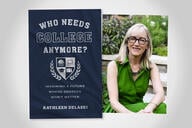You have /5 articles left.
Sign up for a free account or log in.
WASHINGTON -- The U.S. Department of Education hosted an A-list of 150 higher education leaders and "disrupters" for a discussion Monday on how the federal government can encourage the more efficient production of college degrees and credentials.
A recurring theme of the daylong meeting, most of which was off the record, was that policymaking on higher education is a balancing act of encouraging innovation and safeguarding investments. And while the federal government has plenty of influence, it has only the “blunt instruments” of financial aid programs to actually tell colleges what to do.
“It’s an ambitious challenge. None of this is easy,” Arne Duncan, the secretary of education, said at the meeting, which was held at Georgetown University. (Organizers allowed the news media to attend the gathering but requested no quoting of participants, except for Duncan.)
Duncan said the White House wants to help decrease college costs and increase completion rates, all while protecting academic quality.
“The last thing we want to do is hand out paper that isn’t real,” he said.
As a result, Duncan echoed other participants throughout the day in his call for better data, standards, and accountability in higher education. That naturally leads to tension in creating quality-protecting policies without becoming an overly prescriptive regulatory regime. Nobody seems to want a higher ed version of "No Child Left Behind."
Urgency is building around productivity in higher education, however. And online learning is helping drive that urgency, several participants said, in part because many elite universities are now in the game with massive open online courses (MOOCs).
Higher education has also become a serious presidential campaign issue, mostly because of concerns over student debt. For example, President Obama has featured his pledge to curb the rate of tuition increases in television ads. But according to many of the meeting’s participants, federal regulators and accrediting agencies have not done enough to clear red tape for promising approaches, particularly with online education.
'Creative Money'
The New America Foundation conducted a survey of participants prior to the conference, probing their thoughts on innovations in teaching and learning. When asked what are the biggest barriers to adopting those innovations, the respondents listed the credit hour first, with other federal financial aid rules as a runner up and accreditors in third place.
As for what keeps new approaches from being tried by colleges, most of the survey responses cited faculty and institutional culture. Few actual faculty members were invited to the meeting. And no high-profile faculty advocates attended. One professor who was there said he would have preferred a stronger voice for his peers.
As it is with higher ed policy, managing a discussion of potential disruptions to the industry is a tough task. And adequately covering the landscape of MOOCs, competency-based education, course redesign and prior learning assessment in eight hours is impossible.
Whatever the meeting may have lacked in depth, it had in star power. Following Duncan was a panel of top officials from prominent MOOCs, other players in online learning and veteran experts on course redesign. College leaders also had their turn at the dais, with presentations from a high-profile community college, a public college system and a private university with a large online presence. Powerful foundations were well-represented on one panel, and leaders of several of the major higher education associations attended the conference. Technology vendors and for-profit college representatives were also there.
Some representatives from traditional higher education privately expressed frustration with what they felt was an underlying message from the conference's organizers that the four-year college model is “broken,” a premise they said ignores plenty of innovation on college campuses. And, as one participant said during a question-and-answer session, some of the most-celebrated potential disruptions have yet to come up with business plans.
However, Education Department officials repeatedly said during the meeting that they recognize the leadership role faculty must take in any teaching and learning developments. They also said traditional higher education can work in tandem with emerging models.
Several participants called for the department to expand its experimental sites program, under which higher education providers can get federal funding to try new approaches, often without having to clear all the regulatory hurdles. Duncan said “creative money” for programs like experimental sites could be used to identify promising ideas that could be adopted more broadly. But in this budgetary environment, colleges must help find efficiencies on their own. “Institutions have to play as well,” he said.
The department is open to ideas, Duncan said, like competency-based programs, prior learning assessment and contributions from MOOCs. But he said alternative credentials, meaning ones issued by something other than the academy, remain an unproven concept.
“By any measure, college graduates do better than non-college graduates,” said Duncan.




